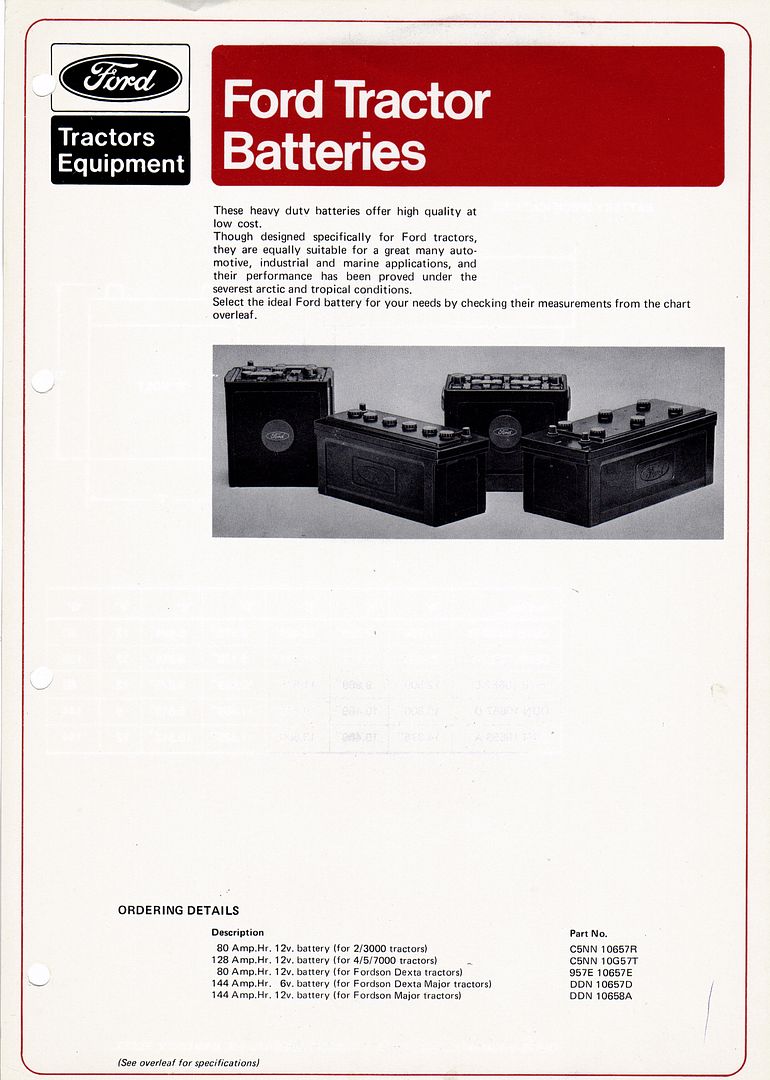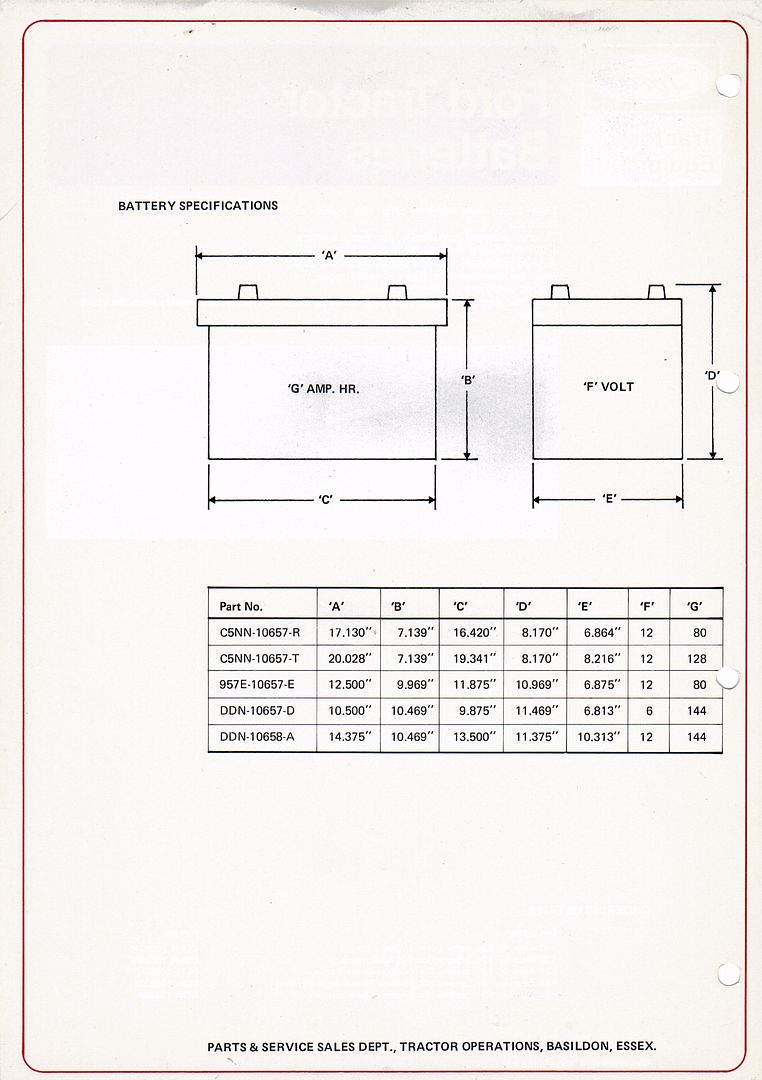Page 1 of 1
Battery
Posted: Fri Apr 20, 2012 5:54 pm
by brinky
Now that I have got the charging sorted out I need to change the battery.
The Major came with a 55ah battery on it which has always struggled to turn it over, I noticed that Agriline sell a 90ah battery for a Major.
My question is if that is the best size and does it make any difference if I put a bigger one on?
Thanks
Re: Battery
Posted: Sat Apr 21, 2012 2:06 am
by whirly
The Ampere Hours rating of a battery is akin to the amount of reserve the battery has. It's kind of like the difference between a 20 gallon barrel of 100 proof whiskey and a 50 gallon barrel of the same whiskey. The proof (voltage) remains the same you just have more reserve

. As long as the battery is 12VDC and fits the space you should be good to go.
Re: Battery
Posted: Sat Apr 21, 2012 8:45 am
by Brian
The ah is also an indication of how the battery is able to cope with the power demanded and stored.
Originally the Major had around 100 ah batteries. These used a plate made from a lead/antimony compound and there were quite a number in each cell. (Back in the day when us olduns knew nothing about green issues, we used to recondition batteries by removing and refitting worn out battery cells rather than throw away the whole battery)

. These batteries were very heavy but 10 to 12 years life was not uncommon.
Battery design changed and later batteries have a lead grid with a lead compound paste inserted in the grid. This is lighter and can be made smaller but is not so durable. Heat generated by the chemical reaction of storing and releasing the charge can cause the lead grid to flex and break up so shortening the batteries life,
If you are using a lower ah battery you are trying to draw your power from a smaller plate area, there is also not the capacity to store a big reserve and the heating by the action within the battery will speed the breakup of the plates and therefore reduce the life of the battery.
Replacing the charge will also cause heat so if you are draining the storage capacity of the battery on start up, causing heat, you will also be heating the plates again by re charging. The rule of thumb is, the maximum charge rate of a battery is 1/10th of the ah reading. With a modern battery it must be taken off charge as soon as it reaches full charge. Alternators and dynamos sense this point and shut down but not all battery chargers do.
We used to leave the old style batteries on "trickle" charge for days on end but if you do that with the new ones you damage the plates and reduce the batteries life.
The higher the ah reading the longer your battery will last, but the higher the cost initially.
(This is a pretty simplistic explaination, ther is a lot more to batteries and battery design than this)

Re: Battery
Posted: Sat Apr 21, 2012 11:24 am
by Dandy Dave
Nice explanation Brian.

Too small of a battery can also cook your starter. Dandy Dave!
Re: Battery
Posted: Sat Apr 21, 2012 12:15 pm
by brinky
Thanks for all the advice, and that would explane the burning smell I got the other day when it wouldn't start

Re: Battery
Posted: Sat Apr 21, 2012 2:38 pm
by Brian
Bit more information on Ford batteries. You will see from this that the recommended ah for a Major is 144ah.


I have also put these on Electrical Information on the "Misc" forum.
Re: Battery
Posted: Sat Apr 21, 2012 4:02 pm
by Pavel
In the old days, and I'm talking about the 50s & 60s, we used to determine a battery's capacity for prolonged grunt and hard yakka by the number of plates it had - 7 plate, 9 plate and with a serious commercial truck/lorry one being 12 plate. We didn't attach much importance to the amp. hour capacity - although it was nearly always stated.
Nowadays the excepted power/capacity designation is CCA -- Cold Cranking Amps. For instance my FSM has a designation 650 CCA and this means that the battery can supply, when fully charged, 650 amps for 30 seconds at a temperature of 0 degrees Fahrenheit [32 degrees of frost].
Hope this helps.
Pavel
Re: Battery
Posted: Sat Apr 21, 2012 5:21 pm
by Brian
The number of plates is a good guide but the ah tells the full story, a battery may have 12 plates per cell, 4" by 4" (for example). The ah would not be as high as a battery with 12 plates per cell 8" by 8" , the ah of the second battery would be far higher if you see what I mean because of the greater surface area.
We had a battery supplier in Norwich, long gone now, called CTS who supplied batteries for Ford tractors at half the price we did, but the life was around a third of the life span. 9 plates against 12 plates per cell.
Do you remember wooden batteries? I am not joking, all the early Nuffield tractors came with a big wooden cased battery.
Re: Battery
Posted: Sun Apr 22, 2012 4:39 pm
by Pavel
No, never heard, or saw wooden encased battery's for vehicles/tractors; but I do remember in the 50s that the long range wireless sets we had in the army were powered by wooden sheathed ones [we called them accumulators]. And as to the plate size - we live and learn.
I guess that down through the ages there are always rip-off merchants to be aware of. Some battery makers today list their batteries as having an HCA capacity instead of CCA with the unwary not realising that this indicates that they were tested at 80F instead of 0 degrees F.
Pavel

